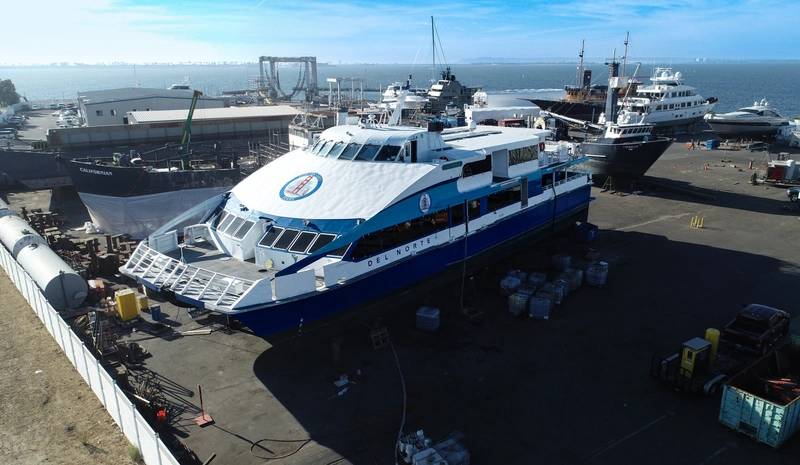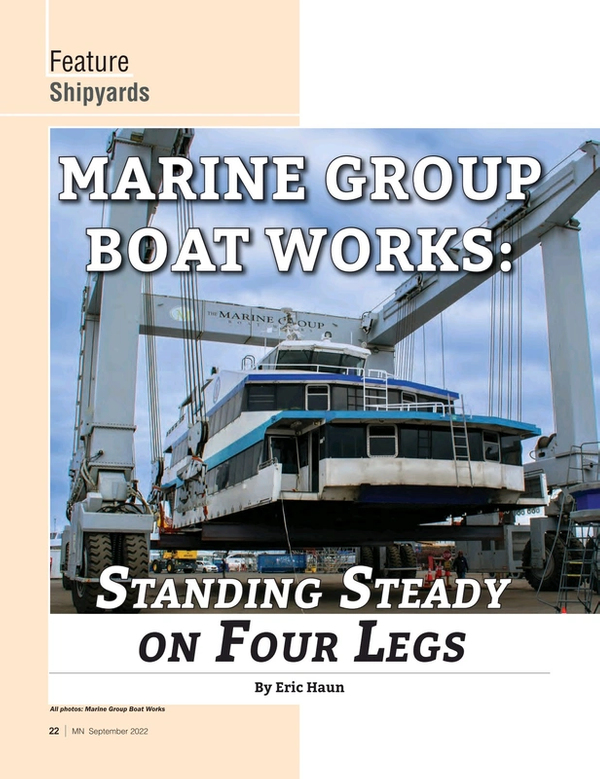
Marine Group Boat Works: Standing Steady on Four Legs
Ask anyone working in the shipyard business, and they’ll tell you balancing yacht, commercial and government vessel repair work concurrently is no easy task. Add a bit of new construction to the mix, and you’ve got Marine Group Boat Works (MGBW), a Chula Vista, Calif. shipyard that has seemingly mastered the balancing act.
“There are a few tricks to the trade,” said MGBW president Todd Roberts, a Cal Maritime graduate with a U.S. Coast Guard license for vessels up to 1,600 tons. “The biggest thing we do is run an extremely clean, environmentally friendly operation. . . What that means is you don’t have anything on the ground, you don’t have anything in the air and you don’t have anything in the water, and this avoids contamination on the yachts. I don’t want to undersell it and say it’s good housekeeping, but that’s exactly what it is, and in our case, it’s to a pretty meticulous level.”
“Now on the flip side, when yachts are washing, which they do frequently, we ask them to do that during low wind period so that we don’t have water going all over our commercial boats when we’re trying to weld and paint,” Roberts said. “It’s a bit of a ballet managing it, but the key is running a really clean operation. If you can do that, then you can do both.”
The other side of the coin, Roberts said, is personnel. “It’s just sort of the way we were raised. When we started the yard, we cross-trained everybody from day one. A welder was a welder, and you’re a craftsman, and what you weld on is irrelevant. And it’s careful oversight by our supervisors and our quality assurance folks, to make sure that our crew members are abiding by yacht quality standards when they’re on a yacht, which is everything from shoes and markings and no tool belts, and nothing that could scratch against something if there’s not proper protection, to shoe covers.”
Over the past three years or so, MGBW’s workload has been about 60% yachts and the remaining 40% a mix of commercial and government vessel projects. From both an operational and business point of view, chasing multiple markets certainly presents a number of challenges. But on the other hand, this model also provides more opportunity as diversification can help a yard stay busy through market dips and cycles. “That’s always been our mantra,” Roberts said. “We call ourselves a three-legged stool, and years ago we added a fourth leg. Our yacht business is one leg of the stool, commercial is another leg, navy repair is another and new construction is the fourth. It’s really hard to fall over when you have four legs.”
MGBW’s new construction work is primarily for the U.S. Navy, and it is currently building two high-speed patrol boats that the U.S. will transfer to Jordan. “We’d like to have a little bit of new construction going on all the time.”
The repair workload is also balanced out by the changing of the seasons. MGBW sees a slowdown in yacht work during the summer months while those vessels are busy cruising, so it fills up with tugs and high-speed ferries because their work is not season-dependent. “We try to give that feedback to our customers. We let the commercial customers and the Navy know, to the extent that they can control their schedule, they probably will get a better value and faster turnaround when you hit us and we’re not our busiest time,” Roberts said. “It’s no different than going to a restaurant on a Tuesday night versus a Friday night. You’re just going to wait less for a table, and you’re probably going to get a better meal.”
MGBW recently completed a fairly large $4.6 million program for Golden Gate Ferry to service and repair four high speed, aluminum passenger ferries: Del Norte, Mendocino, Golden Gate and Napa. The work scope included everything from routine maintenance, inspection and paint, to waterjet replacements and major structural repairs that required MGBW to remove a superstructure from the hull of one of the ferries. Notably, the project wrapped up ahead of schedule at a time when many shipyards are plagued by supply chain challenges.
“Supply chain continues to be a challenge for us all. And the only thing you can do is work collaboratively with your customer to get the contract awards early and before the vessel arrives, and get that material ordered immediately and on the ground prior to the vessel’s arrival. If you do, you can do amazing things for your customer.”
Roberts said MGBW has taken that approach with Golden Gate Ferry, working collaboratively with their contracting team to change how contracts are awarded. “It used to be that they awarded the contract and you took the boat and did the work. Now we’re working in an environment where the contract is awarded, then we receive a notice to proceed before we take delivery of the boat, allowing us to get our materials lined up,” Roberts explained. “We also take an extra step of doing a survey of the boat prior to arrival to identify any potential growth work. And then, given that we have such a strong relationship with Golden Gate, we typically order material—aluminum, bearings, whatever it may be—and keep it in inventory. At the end of the day, it’s a collaborative effort with your customer to make sure that the scope is well defined and the material is procured as early as possible.”
MGBW has been keeping busy, thanks in part to its reputation for a job well done—and completed on time. Its yacht business has been strong, with two recent multimillion-dollar refit awards, and the company seems to almost always be servicing a vessel from the Golden Gate Ferry fleet.
 (Photo: Marine Group Boat Works)
(Photo: Marine Group Boat Works)
Roberts said MGBW recently did some work for Edison Chouest Offshore where it as able to haul a series of tractor tugs in a row to get them through their credit dry dock process. “There’s seven of these tugs, and they’re used to support the Navy’s fleet here in San Diego. Obviously having those boats up and down very quickly is important,” Roberts said.
Roberts also mentioned two large tug projects for Crowley, including one that saw MGBW repaint the vessel from red to Crowley’s new blue. “According to Crowley, nobody has been able to maintain their schedule as well as Marine Group’s been able to. And they’ve been very happy with the value that we’re offering,” Roberts said.
And with new stricter emissions rules coming down the line for harbor craft in California, MGBW is about to get a whole lot busier amid a sharp demand increase for repower and even new construction projects. “We were ready to see an uptick in the activity and then CARB pushed the rules to the right a little bit,” Roberts said. “What we’re seeing in the industry is everybody just sort of put their head down and breathed a sigh of relief. They’re going to worry about it another time.”
But Roberts said this approach may backfire, leaving owners in a game of musical chairs as they try to find a yard that can take on their repower or newbuild project amid soaring demand. “If I were a vessel owner, I would be repowering sooner rather than later because there’s very limited facilities in California that can do the kind of work that will be necessary. And if you rush them all at one time, capacity is going to get swallowed up, and you could be left sitting at the dock.”
 “We call ourselves a three-legged stool, and years ago we added a fourth leg. Our yacht business is one leg of the stool, commercial is another leg, navy repair is another and new construction is the fourth. It’s really hard to fall over when you have four legs.” - Todd Roberts, president, MGBW (Photo: Marine Group Boat Works)
“We call ourselves a three-legged stool, and years ago we added a fourth leg. Our yacht business is one leg of the stool, commercial is another leg, navy repair is another and new construction is the fourth. It’s really hard to fall over when you have four legs.” - Todd Roberts, president, MGBW (Photo: Marine Group Boat Works)
Read Marine Group Boat Works: Standing Steady on Four Legs in Pdf, Flash or Html5 edition of September 2022 Marine News
Other stories from September 2022 issue
Content
- Roundtable: North American Naval Architects Weigh In page: 12
- Congress: Short-term Funding Decisions Create Long-term Domestic and National Security Issues page: 19
- Marine Group Boat Works: Standing Steady on Four Legs page: 22
- Inland Waterways Report: Columbia-Snake River System page: 32
- Silverback Marine Brings Fresh Blood—and Ideas—to Boatbuilding page: 38


